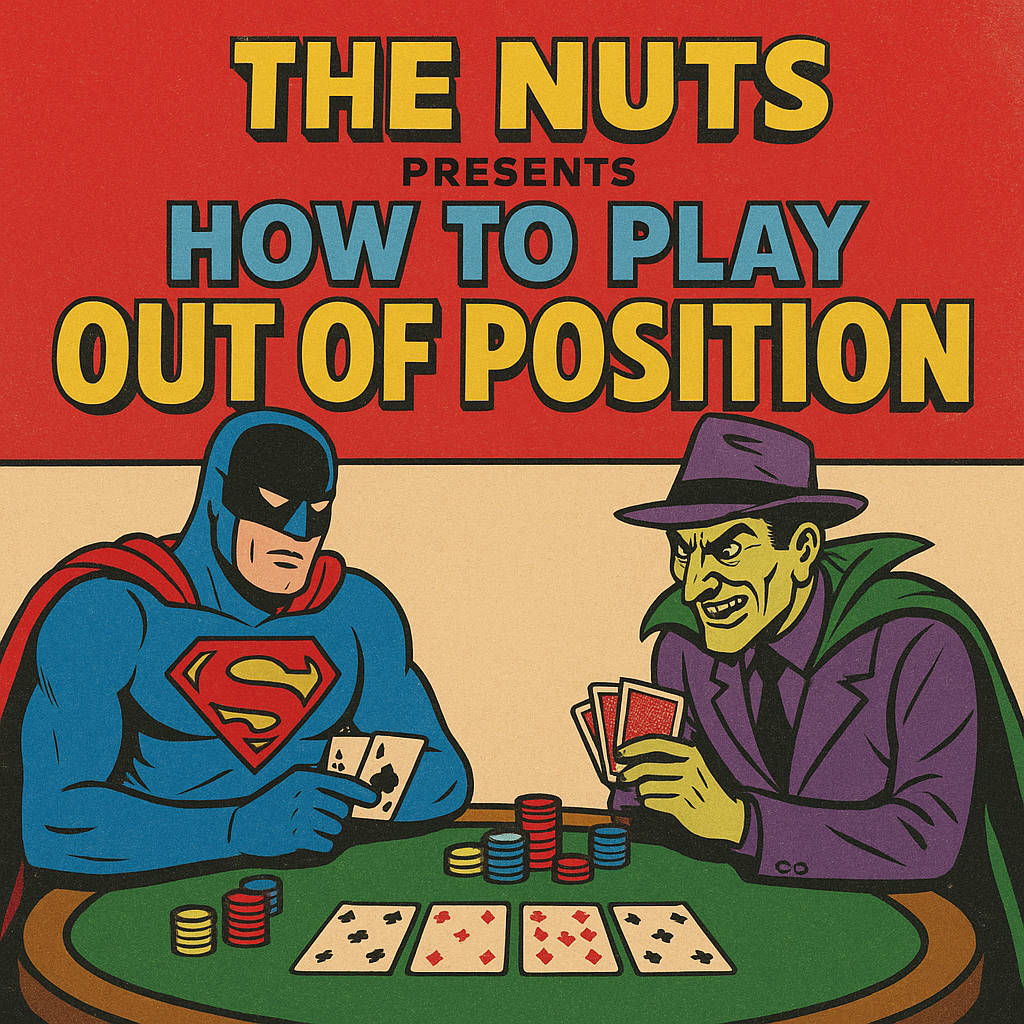Beginner — Step-by-step
- Preflop hand selection (keep it tight OOP)
- If you’re opening from an early/middle position and will be OOP vs later players, favor strong value hands and broadways: AA–99, AK, AQ, AJ (suited higher), KQ suited.
- Avoid: weak offsuit hands and lots of speculative suited connectors when you expect to be OOP and the stacks are shallow-to-medium. Those rely on playing postflop in position.
- 3-bet and fold more (don’t call too many opens)
- If facing a raise and you’ll be OOP postflop, 3-bet for value or fold more often than a flat call with marginal hands. Playing a big pot OOP with marginal calling hands is a leak.
- Postflop — default to pot control
- With medium-strength hands (middle pair, top pair with weak kicker, draws), check and keep the pot small. Acting first gives the initiative to your opponent — don’t gift them free cards when you’re likely behind.
- With strong hands (two pair+, strong made hands), value bet — but size carefully so you get called by worse and protect vs draws.
- C-bet less often
- As OOP you usually have a range disadvantage on many flops. Don’t auto continuation-bet every time. C-bet when you have real equity (made hand or decent draw) or when the board is dry and likely to fold the opponent’s range.
- Use simple floats
- If IP (in position) c-bets frequently on certain board textures, float (call the flop) with a plan to take the pot away on a later street when they show weakness, or when you pick up equity.
- Avoid multiway battles with marginal hands OOP
- Multiway pots make being OOP much worse. Tighten up or fold marginal hands preflop in multiway pots.
- Short stack vs deep stack differences
- Short (<40bb): play more straightforward — commit with top-pair+ when SPR (stack-to-pot ratio) is low.
- Deep (>100bb): speculative hands gain value, but be mindful of being OOP — you still need to reduce marginal OOP situations.
Intermediate — step-by-step adjustments & advanced ideas
- Exploit opponents, then balance
- If an opponent over-folds to C-bets or turn barrels, increase your bluff frequency on those spots, even OOP.
- If they don’t fold enough, reduce bluffs and value bet more. Exploit first; only worry about balance if you play against regs who adjust.
- Use preflop 3-bets to avoid OOP
- If you frequently end up OOP vs a specific player, 3-bet preflop to take initiative or to isolate them. A successful 3-bet often gets you IP or narrows their calling range.
- Sizing strategy OOP
- Value bets: size to extract — small-to-medium sizing to get worse hands to call; larger sizing when you must fold out equity (charge draws).
- Bluffs: ensure you have blockers (e.g., holding an ace when bluffing into a range that fears an ace) and at least some equity (backdoor draws). Don’t bluff multi-street without a plan.
- Check-raise as a defensive/constructive tool
- Use check-raise selectively with nuts/semistrong hands or polarized bluffs. It’s a way to punish aggressive IP players and take the initiative.
- SPR management
- Know SPR (stack size / pot size). With a low SPR (≈1–3) commit with top pair+ or strong hands. With high SPR, avoid overcommitting with vulnerable top pairs; play smaller or check-call until you can deny free cards or get to showdown cheaply.
- Blockers & card removal
- Use blocker effects when bluffing OOP. Having an Ace or King can make bluffs more credible against opponents who fear those ranks.
- Multi-street planning
- Always have a plan — if you call the flop, know what you’ll do on the turn if checked to: check-call, check-fold, or bet as a bluff/value. Don’t “play street by street” without a plan.
Common board textures & quick reactions
- Dry boards (K-7-2 rainbow): OOP you can c-bet more if you have a hand or block strong combos; good spot to bluff if IP checks a lot.
- Wet/connected boards (J-T-9 with two suits): be cautious — lots of draws and combos; prefer checking and pot control unless you have the nuts or strong draw.
- Paired boards (8-8-2): strong for slow-played pairs — check more; value bet bigger when ahead because it’s hard for drawing hands to have value.
Short, practical sample lines (concrete examples)
- You: MP open, BTN calls. Flop: K-7-2 rainbow. You hold A-K.
- You have top pair, top kicker. Bet for value/protection (don’t check and let BTN decide). Size to get called by worse (medium size); be ready to barrel turn if a scary card hits.
- You: SB defend vs BTN open with A5s (deep stacks). Flop: J-9-4 with two suits.
- Weak made + backdoor. Check and call small bets if IP c-bets often; don’t lead unless you plan to bluff and know BTN folds too often.
- You: Facing IP frequent c-bettor on dry boards.
- Float the flop with hands like Kx, Qx, then bluff-turn if they give up. Exploit their frequency.
Practical drills to improve OOP (do these in short sessions)
- Preflop discipline drill: Track 100 hands and mark how many times you go OOP with marginal holdings. Try to cut that in half next session.
- C-bet frequency drill: For one session, force yourself to c-bet ≤ 40% of flops when OOP; note which boards you c-bet and the outcomes.
- Turn plan drill: After every flop call that session, write down (mentally) your turn plan before you see it: fold, bet, raise, or check-call. Review afterwards.
Common leaks & what to avoid
- Calling too often preflop with marginal hands and getting OOP in multiway pots.
- Auto-c-betting on every flop OOP.
- Bluffing multi-street without blockers or backup equity.
- Letting frustration from being OOP make you play thinly (tilt plays).
Wanna give poker a try, join PokerBet now! It’s FREE to join!




